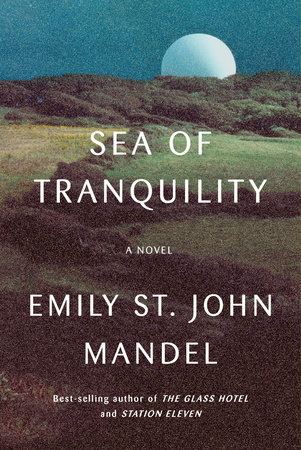Sea of Tranquility: A Novel
- By Emily St. John Mandel
- Knopf
- 272 pp.
- Reviewed by Andrea M. Pawley
- April 11, 2022
Time’s fungibility is used to dramatic effect in this mesmerizing tale.

Bestselling author Emily St. John Mandel wrote and published Sea of Tranquility during a pandemic, so the novel must be about pandemics, right? Well, unseen, ubiquitous doom is its overall feeling. Incomprehensible danger suffuses settings that should be beautiful. Fear, confusion, and longing distort the passage of time, especially for the character Olive, who is on a book tour to support her blockbuster novel Marienbad. That book is about a fictional pandemic. It follows, then, that Sea of Tranquility seeks to capture how people feel during pandemics, right?
Not so fast.
What if St. John Mandel instead means to pick up where another masterpiece left off? Like Sea of Tranquility, the real-life 1961 avant-garde French film “Last Year at Marienbad” is focused on the meaning of reality, the flow of time, and the validity of memory.
The first half of Sea of Tranquility moves forward in time through three stories — Edwin’s in 1912, Mirella’s in 2020, and Olive’s in 2203. In 1912, Edwin has been exiled to Canada for making improper statements about colonialism to his British parents. After six listless months in Nova Scotia, Edwin, who is “capable of action but prone to inertia,” tags along with a more ambitious countryman to Saskatchewan.
On the train ride there, Edwin “can see from horizon to horizon” and “feels terribly overexposed.” Whatever lurks seems close to his isolated homestead despite the immense distances that surround him. Fear crowds his reality and distorts his perceptions. Saskatchewan is not for Edwin.
Later, in British Columbia, he discovers a land eerily devoid of people. Trees overcrowd ubiquitous forests. That “queasy sense of overexposure that he felt on the prairies” returns. He is out of place. Seeking solace in the woods, he instead endures a disturbing episode of disorientation filled with music and baffling noise. Edwin’s impression is of having been suddenly in a large space, “like a train station or a cathedral.”
The experience leaves him vomiting and in a blind panic. Moments later, however, he isn’t sure he remembers the incident correctly, and he soon distrusts the stranger who questions him about it. Edwin’s profoundly bewildering experience in the forest resurfaces in all the Sea of Tranquility narratives that follow.
The characters in the film “Last Year at Marienbad” are disoriented, too. They wander through a vast palace converted into a hotel. Indistinct chatter fills their lives. Discordant music clangs through the halls. Hotel guests cannot comprehend what is going on now or what has happened in the past. Surely, the work informed St. John Mandel’s writing of this novel.
When Sea of Tranquility moves to January 2020, the character Mirella seeks closure. A friend with whom she had a falling out has died. The friend’s husband defrauded Mirella’s social circle in a Ponzi scheme. Only recently has Mirella come to understand how this late friend might not have recognized what her husband was doing. Mirella’s view of reality shifts.
She later waits in a chilly New York City alley for a star performer to emerge after a show. This performer is the deceased friend’s brother, and Mirella hopes to question him. But she’s not the only one. Someone else in the alley wants to ask him about a certain clip he used during his show — a clip that may have captured the same moment of confusion and horror Edwin suffered decades earlier. This person is oddly fixated on obtaining answers.
The protagonist in “Last Year at Marienbad” is likewise on a relentless quest for answers. He wants to know if the woman he seeks — who won’t say whether she’s met him, much less if they’ve been intimate — is ready to be with him. The man’s memory of their time together is distinct; hers is unreliable and fraught. The shape of their reality is unclear. Perhaps nothing is real.
Sea of Tranquility’s Olive, the bestselling author in the year 2203, knows what’s real. Or, at least, she once knew. Marienbad has made her so famous that her book tour stretches to Mars and back. Yet the overly long junket grows ever more discombobulating. Time loses meaning. Besides, a pandemic is brewing just like in Marienbad. The parallels leave Olive unmoored and questioning her sanity. As the tour moves forward, her memories slide endlessly backward.
A journalist (who isn’t a journalist) interviewing Olive doesn’t ask normal questions. Instead, he wants to know about her recollection of a bizarre, discomfiting incident she once witnessed. The story of this journalist makes up much of the book’s second half, which moves around in time. This is where St. John Mandel’s novel diverges from the inscrutable “Last Year at Marienbad,” which leaves all the big questions unanswered.
In unspooling the stories of Edwin, Mirella, Olive, and the stranger, Sea of Tranquility explores what constitutes reality, how time flows, and what memory is in the context of perception. The answers given aren’t the end of the debate but the continuation of the conversation. It makes for a mesmerizing novel that is both hard to put down and impossible to stop thinking about.
Andrea M. Pawley lives and writes in Washington, DC, her favorite city in the whole world.

